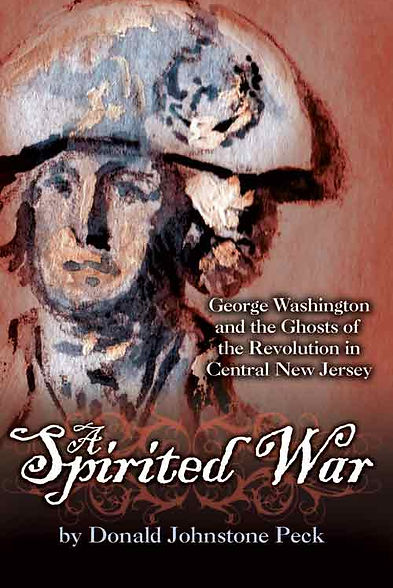
- Central New Jersey Author and Historian -
Donald Johnstone Peck

“We shall not cease from exploration. And at the end of all our exploration will be to arrive where we started and know the place for the first time.”
-T.S. Eliot

George Washington and the
Ghosts of the Revolution in
Central New Jersey
New Jersey has recently been hailed as the “Crossroads of the American Revolution.” This is a fitting designation, given that General George Washington spent the majority of his time in the colony, and engaged the British in several decisive battles within its borders. In fact, a large portion of the War for Independence may be said to have been won in the counties of Middlesex, Somerset, Monmouth and Mercer, where shifting loyalties and local resistance on both sides presented a constant challenge to the combatants.
Have all physical vestiges of the Revolution vanished from the Garden State? Not at all. In fact, the reader will be pleasantly surprised to discover that many historic sites still do exist, places that offer us a genuine glimpse into the Spirited War of the times. Donald Peck and his companion Jane Doherty lead us on an in-depth tour of many of these Midland sites, each interpreting the facts from their individual point of view. As historian and psychic, they provide a fresh analysis of events that took place in the area, along with explanations of the personalities involved in them. The result is a very readable and exciting narrative, one that affords us an entirely new perspective on the past that surrounds us.
A Spirited War
Besides George Washington, readers will discover that other Revolutionary War heroes were associated with Central New Jersey, among them Benjamin and William Franklin, John Adams, Aaron Burr, Nathaneal Greene, Charles Lee, and the Marquis de Lafayette. Numerous battles also took place on its soil, including Washington’s Retreat across New Jersey in 1776, the crucial Battles of Trenton, Princeton, and Monmouth in 1776-1778, the Battle of Springfield in 1780, and the celebrated march to victory with the French, led by the Comte de Rochambeau, in 1781. New Jersey’s truly was the “Crossroads of the American Revolution”, and A Spirited War will prove it!
Format: 6" x 9" perfexct bound paperback on acid-free paper with glossy laminate cover
Pages: 206, including table of contents, acknowledgments, preface, foreword, bibliography and complete index.
Illustrations: Historical images, line drawings, maps and photorgraphs
ISBN 13: 978-0-9842256-2-0
ISBN 10: 0-9842256-2-5
LCCN: 2009938285
THE BOOKS
Perth Amboy – The Capital
And Port City On
Raritan Bay 1683-1790
When his Excellency the royal governor of New Jersey, William Franklin was arrested on June 19, 1776 at the Proprietary House in Amboy, a stronghold of Anglicanism, the residence of many of the royal governors of New Jersey and New York, influential proprietors and government officials, the remaining colonial days of this capital city drastically changed.
While William Franklin appeared before the Provincial Congress on June 21, and the court he refused to recognize tried him, congressional delegate Thomas Jefferson of Virginia was delivering his first draft of the Declaration of Independence to John Adams for his review. And on that very same day, the New Jersey Provincial Congress voted 53-3 to declare independence from Great Britain.
An American
Journey of Hope
Historian, Donald Johnstone Peck chronicles how the founding colonial society of Perth Amboy, distinctive because of its old world connections with heredity, aristocracies, feudal land systems, established church, omnipotent governments and slavery found itself also the inheritors of political and religious forces that held forth the promise of plenty and a way of life that emphasized freedom and opportunity for all. It was the vision of the founding Twenty-Four Proprietors of East Jersey, most of whom were Quakers, to establish a colony for persecuted Scottish Quakers. However, in accordance with the Quaker plan to help the oppressed and suffering, to rescue prisoners and exiles and provide them with religious toleration, Perth Amboy became the port of entry for both Quaker and Calvinist Scottish Non-conformist Presbyterian Covenanters who would subsequently establish the Presbyterian Church in America.An American Journey of Hope is the story about the conflict between a stronghold of very prominent Loyalists and their engagement with many of America’s leading patriots in the struggle for American religious and political independence. The book also provides a unique lens through which to observe a revolution that overturned the old order.
